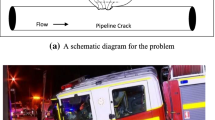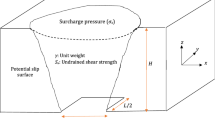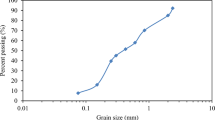Abstract
Experiments show that the sinkholes’ sizes and shapes are related to their stability. After a sinkhole has been created, its geometry continually evolves towards a more stable form. This process is governed by characteristics of the surrounding geomaterials, and various physical interactions, such as weathering, stress variations caused by cycles of wetting-drying. Buried, dropout and suffosion sinkholes are formed in the soil layer overlying bedrock. Dropout sinkholes (i.e. those with overhanging arches) are more likely to form in cohesive soil; suffosion sinkholes (i.e. those without overhanging arches) are more likely to form in non-cohesive soil. In the literature, most mechanistic analyses focus on dropout sinkhole. Few researchers conduct stability analysis of suffosion sinkhole. The geometry of a sinkhole is an input into most stability analyses, but it is often idealised or back-calculated from post-failure data. There is a need to know the geometry of a sinkhole approaching the point of failure (i.e. the limiting equilibrium). This paper reports on the geometry of collapsed suffosion sinkholes at limiting equilibrium obtained by the slip line theory. Analyses consider nonhomogeneous soils satisfying static equilibrium with soil strength governed by the Mohr-Coulomb failure criterion. The limiting sinkhole geometry is shown to be governed by dimensionless parameters. Exemplary charts are presented for determining this critical geometry given different combinations of soil parameters. Applications are illustrated via an example.
Access this chapter
Tax calculation will be finalised at checkout
Purchases are for personal use only
Similar content being viewed by others
References
White WB (1988) Geomorphology and hydrology of karst terrains. Oxford University Press, Oxford, UK
Ford D, Williams P (2007) Karst hydrogeology and geomorphology. England, Wileys
Waltham T, Bell F, Culshaw M (2005) Sinkholes and subsidence: karst and cavernous rocks in engineering and construction. Springer, Berlin
Howell FT, Jenkins PL (1984) Centrifuge modelling in flow prediction studies of granular materials. In: Symposium on application of centrifuge modelling to geotechnical design. A. A. Balkema, Manchester, UK
Craig WH (1990) Collapse of cohesive overburden following removal of support. Can Geotech J 27:355–364
Abdulla WA, Goodings DJ (1996) Modeling of sinkholes in weakly cemented sand. J Geotech Eng 122(12):998–1005
Vo T, Russell AR (2016) Bearing capacity of strip footing on unsaturated soils by the slip line theory. Comput Geotech 74:122–131
Vo T, Russell AR (2017) Stability charts for curvilinear slopes in unsaturated soils. Soils Found 57(4):543–556
Jamal SE (1986) The Winter Park sinkhole and Central Florida sinkhole type subsidence. In The 3rd international symposium on land subsidence, Venice, Italy
Jammal and Associates I (1982) The Winter Park sinkhole: a report to the city of Winter Park. Florida, USA
Gray KM (2014) Central Florida sinkhole evaluation. Florida Department of Transportation, Florida, USA
Author information
Authors and Affiliations
Corresponding author
Editor information
Editors and Affiliations
Rights and permissions
Copyright information
© 2021 The Author(s), under exclusive license to Springer Nature Singapore Pte Ltd.
About this paper
Cite this paper
Kimiko, R.A., Thanh, V., Russell, R.A. (2021). The Shapes of Collapsed Sinkholes at Limiting Equilibrium. In: Bui-Tien, T., Nguyen Ngoc, L., De Roeck, G. (eds) Proceedings of the 3rd International Conference on Sustainability in Civil Engineering. Lecture Notes in Civil Engineering, vol 145. Springer, Singapore. https://doi.org/10.1007/978-981-16-0053-1_17
Download citation
DOI: https://doi.org/10.1007/978-981-16-0053-1_17
Published:
Publisher Name: Springer, Singapore
Print ISBN: 978-981-16-0052-4
Online ISBN: 978-981-16-0053-1
eBook Packages: EngineeringEngineering (R0)




